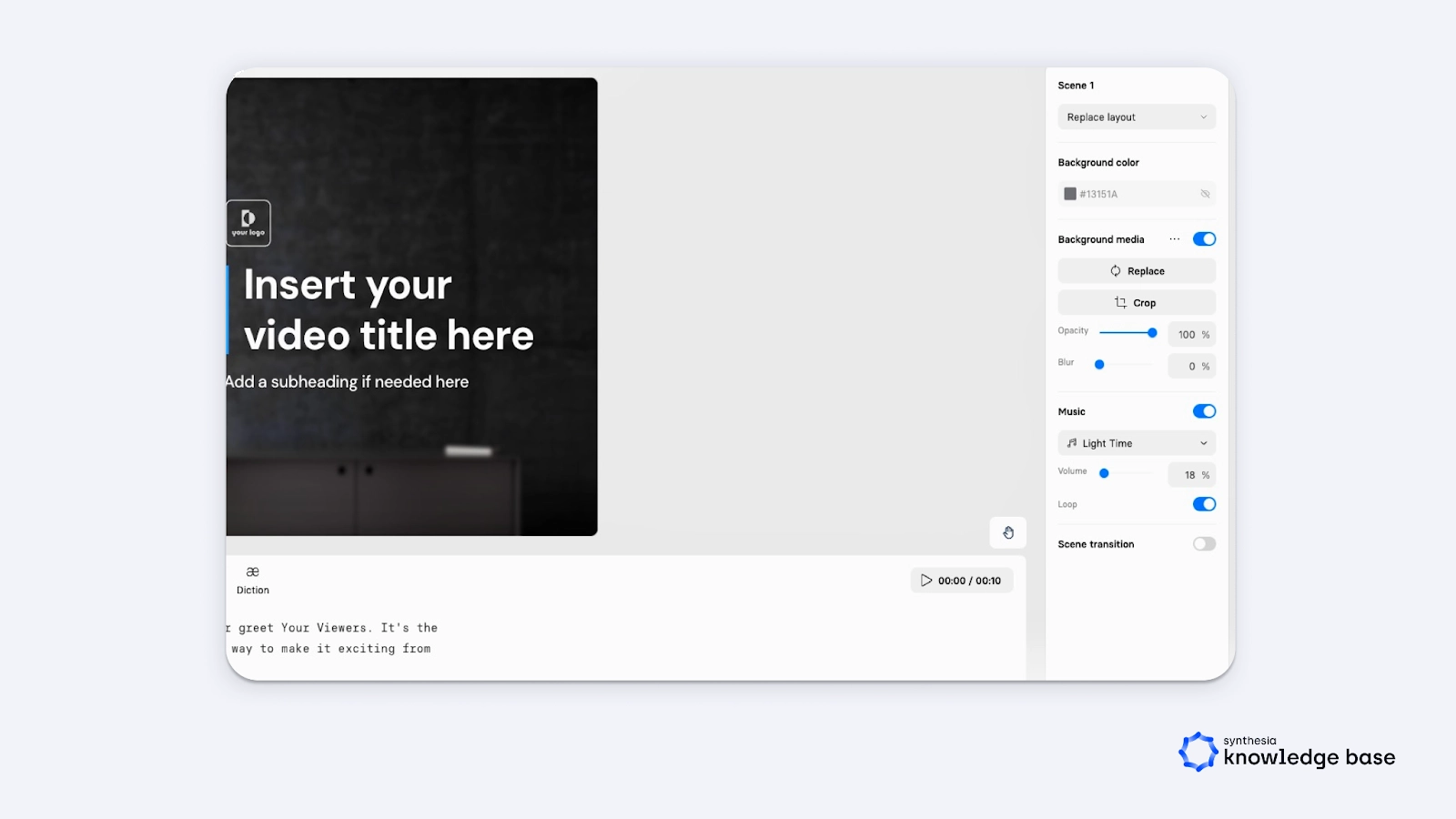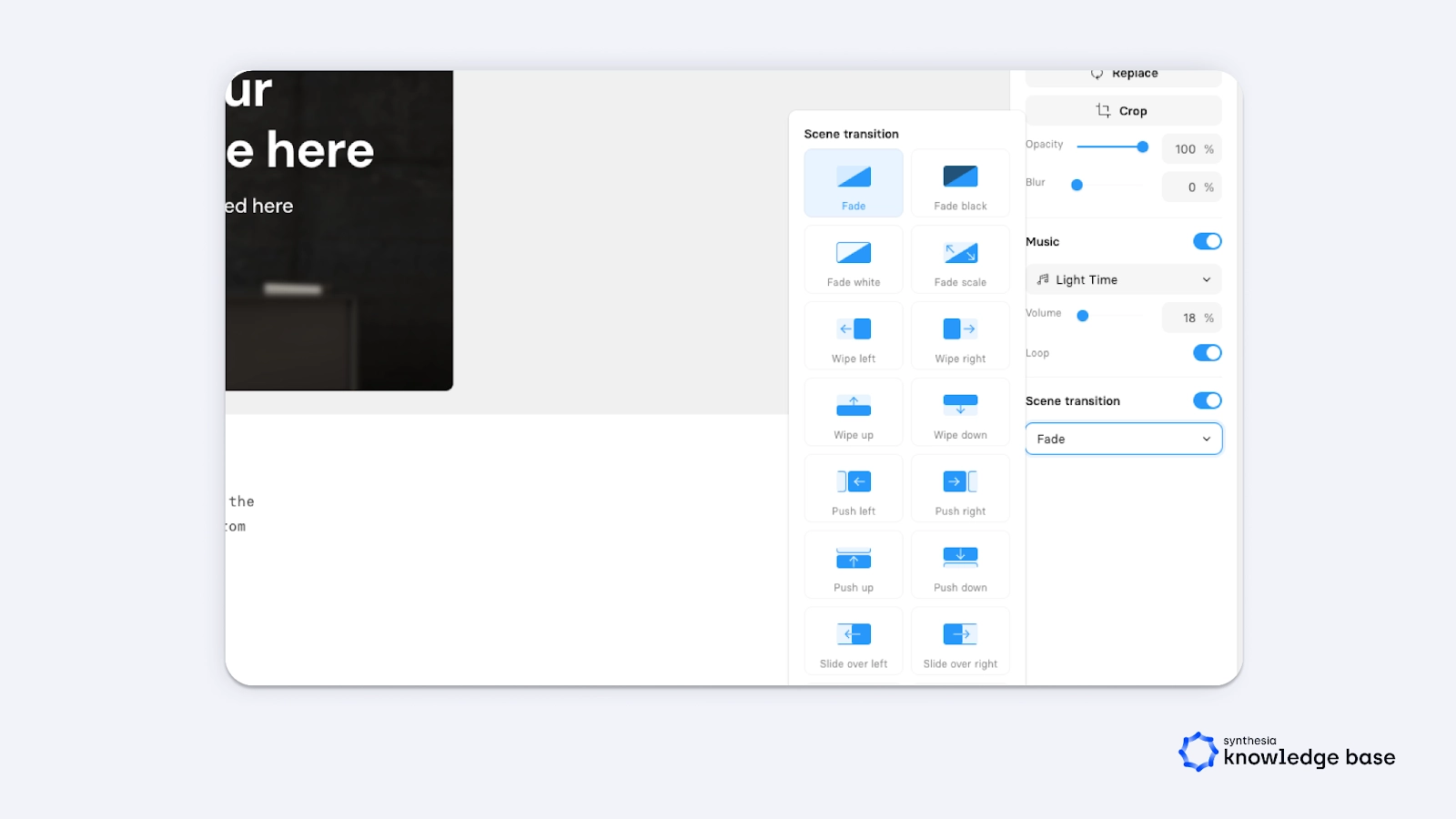
Create AI videos with 230+ avatars in 140+ languages.
Good design should go unnoticed. Transitions in video editing are one of the most overused, misunderstood design elements. Either they enhance your video and improve your narrative and watch time…
…or they can turn your precious video into something that reminds viewers of an eight-year-old's PowerPoint presentation!
They can be so tricky to use that some folks don't even touch video transition effects. This is a crying shame because video editing transitions can also be exactly what your content needs to grab attention and stand out.
This guide contains:
- The best video transitions for professional, fluid edits.
- When and how to experiment with different video transitions effects.
- Examples of what each video transition looks like in action.
What are video transitions?
A transition is a post-production technique that smooths the change from one scene to the next, unlike a one-shot video, which unfolds in a single continuous take without cuts. It can be a simple cut from one shot to another, where a sequence instantly replaces another. Or it can be a complex, multi-layered graphical overlay that moves the viewer through the narrative.
The best transition effects for videos aren't just about linking scenes. By carefully selecting and applying transitions, video creators can:
- Enhance storytelling and convey a specific mood.
- Set the pace of the narrative and indicate the passage of time.
- Introduce new segments or different locations of the story without jarring the audience.
Professional editors use advanced video editing software like Adobe Premiere Pro or Final Cut Pro to add transitions. Creators also use drag-and-drop editing software like CapCut, Synthesia, or TikTok's built-in editor. These alternatives are great for creators of all levels who prefer more user-friendly functionalities.
Examples of transition effects in video editing
While some filmmakers favor the challenge of creating a one-shot sequence that captures the essence of a scene without cuts, transitions offer a dynamic way to connect two scenes seamlessly. That's why they're helpful in any video production, from films and TV to corporate instructional videos.
Below are the seven most common types of video transitions, with examples and details on when they work best.
1. Fade video transition
Fade is a classic transition that can make a scene fade in or out, fade from black, white, or even another color. Essentially, a fade signifies completion and tells the video software to reduce a scene's opacity (which means transparency) over your chosen period.
Generally, fade transitions are used at the beginning or end of a scene or when you want to add a significant pause in the narrative. It's common to make the first video scene fade on, and the last scene fade off to produce a more professional-looking video.
Fades are great for signaling the end of one topic and the start of another, providing a clear division between different sections of your video.
If you fade one clip into the second clip, it can look like a dissolve transition. So you can still create a "dissolve" look using a fade transition!
2. Dissolve video transition
A staple in old Hollywood movies, dissolve is a seamless transition effect that helps you overlap two shots and comes in two forms — cross and film.
A cross dissolve shows one scene gradually fading out while the next scene simultaneously fades in. It's commonly used in video editing projects to signify time passing, a location change, or a soft transition between segments. In instructional videos, the cross dissolve helps transition from theoretical explanations to practical demonstrations, indicating a shift in focus but maintaining a thematic connection.
While cross dissolves are standard, you can also get different forms of this dramatic transition to create a slightly more nuanced look. The so-called film dissolves rely on color and sometimes texture to produce different looks.
Check out the video below to see the difference between a cross dissolve and a film dissolve side-by-side:
3. Wipe video transition
At its core, the wipe is a simple video transition effect that moves across the screen, replacing one sequence with another. Different wipes can transition to the left, right, up, or down, often showing a location change or building tension.
To see some wipe transitions in action, check out the video below from the original Star Wars trilogy, where it was intensively used to move between storylines.
A wipe transition is great for more educational content, too. For example, in tutorial video clips, you can use wipe transitions to switch between different perspectives or locations, like moving the narration from a classroom setting to real-world applications.
4. Push video transition
As the name suggests, the push transition is all about giving the impression of one sequence pushing the other off the screen.
Pushes can go left, right, up, or down — the direction doesn't matter much as long as you're consistent. The goal is to indicate a forceful change in the narrative or a significant shift in the storyline.
If, for instance, you're editing a how-to video, this transition can emphasize the progression from one step to another. The push transition is a great choice to create a visual suggestion of forward movement in learning.
5. Slide-over video transition
Slide-over video transitions help move from one shot to reveal new information or move smoothly between topics, and they can also have a humorous effect, depending on context.
Like the push transitions, slides can go left, right, up, or down and make it look like one scene is sliding over and replacing the other.
Step-by-step instructions given by onboarding videos or product assembly video clips can benefit from this type of video transition. In these videos, each new step slides in to replace the previous one, maintaining a continuous flow of information.
6. Whip-pan video transition
With the whip pan, the camera moves horizontally from one subject to another, creating a brief, disorienting motion blur that connects two video clips.
In action sequences, the whip adds dynamism. In comic movies, it maintains a brisk pace, creates visual humor, and can even emphasize character reactions. And in romantic comedies, whip transitions symbolize the lead is busy or overwhelmed, creating a lighthearted comedic effect.
The whip pan transition can create a sense of rapid movement that simulates the immersive feel of a one-shot sequence by connecting two clips with a swift, fluid motion. It can add energy and keep viewers engaged by moving quickly between different elements or sections, especially in a fast-paced instructional video.
7. Zoom video transition
Zoom transitions move in or out of a scene at different speeds. They create a sense of urgency or focus when they're fast and highlight a particular detail within a scene, concentrating on a person or object when they're slow.
Movies use the slow zoom transition for landscapes, while televisions use it in interviews or when they want to change the camera from reporters who have been talking for some time.
You can use a zoom transition in almost any video clip, from music videos and social media posts to blockbusters. Overall, zooms are great ways to keep people learning and watching with their full attention.
3 Video transition tips to make cool edits
Transitions are fun to use and experiment with but are not mandatory. More is less when using them, so resist overusing video transitions, especially if you're new to editing. Here are a few quick tips on how to make the most of these creative transitions.
Tip 1: Work with user-friendly video editors
User-friendly video editors can streamline the process of adding transitions to your videos. You quickly add and test different transitions without worrying that you're messing up your video. And thanks to their intuitive interface, they're accessible even for those with minimal video editing experience.
For example, adding a transition in an AI video maker like Synthesia is straightforward. This text-to-video tool lets you easily edit each scene in your instructional video and select great transitions from an intuitive interface in just three simple steps:
Step 1: Select a scene
Start by choosing the scene to which you want to add a transition from the scenes list on the left side of the screen.
Step 2: Enable transitions
On the right-hand side of Synthesia, there is a Scene transition toggle. Turn this on to enable transitions for the selected scene.

Step 3: Choose the transition type
Once the Scene transition is activated, a dropdown menu appears, offering a variety of transition styles. You can select the style that best suits your video's narrative and aesthetic.

To add effects to other scenes or change the effect in a previous scene, repeat this process.
Tip 2: Be intentional with your transitions
Adding creative transitions just for fun can damage your video's performance.
Each transition you use should have a clear intention. Whether it's to guide the viewer's focus, differentiate between sections or steps, provide visual variety, or make instructional videos more engaging, you must have a reason for using it.
And if you can't find a reason or don't know which one to use, it's better to do a standard cut without any transition.
Tip 3: Use transitions subtly and sparingly
Overuse or a combination of different transitions and effects can distract viewers and detract from your video's message. Use transitions sparingly and opt for minimal, smooth effects that enhance the storytelling without overwhelming the content.
Rather than using them to transform your content, keep the focus on the actual narrative and add transitions only to slightly polish your video's look.
Create stunning videos with seamless transitions
Ready to turn ordinary content into engaging instructionals and take your video narrative to the next level?
Experiment with the AI video maker Synthesia to add video transitions and see exactly how they impact your content.
Create an AI video with our free AI video generator and watch this webinar on how to make instructional content pop with elegant video effects:
About the author
Content Writer & Marketing Expert
Ema Lukan
Ema Lukan is a seasoned Content Writer and Marketing Expert with a rich history of collaborating with marketing agencies, SaaS companies, and film studios. Her skill set encompasses copywriting, content creation, and a profound understanding of the intricate fabric of brand identity. Ema distinguishes herself not merely as a wordsmith but as a storyteller who comprehends the power of narratives in the digital landscape. Fascinated by new technologies, she navigates the evolving marketing terrain with creativity and analytical precision, leveraging data to refine strategies. Her passion lies in crafting compelling stories that resonate, always mindful of the ever-changing dynamics in the digital world and the culture shaping it.















